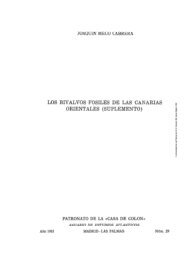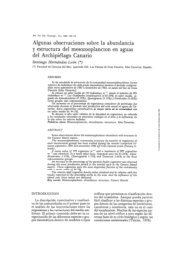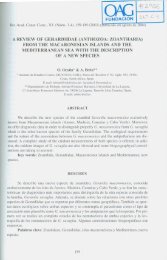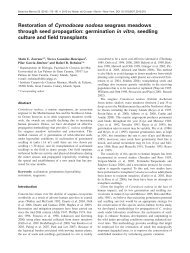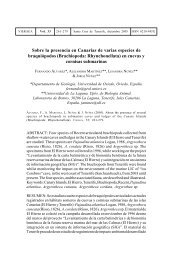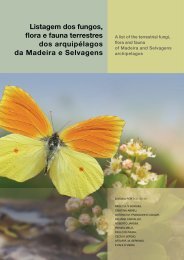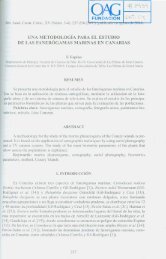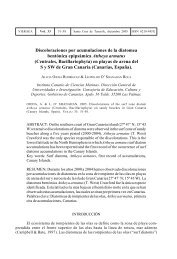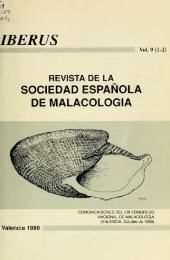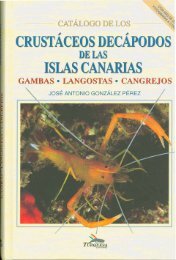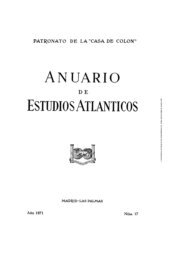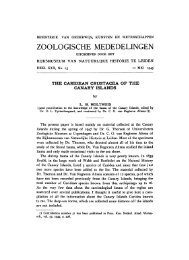376 V.M. Tuset et al. / Fisheries Re<strong>sea</strong>rch 109 (2011) 373–378 Fig. 4. Phases of egg <strong>development</strong>. (For <strong>in</strong>terpretation of the references to color <strong>in</strong> this figure legend, the reader is refer<strong>red</strong> to the web version of the article.) while <strong>in</strong> C. qu<strong>in</strong>quedens they are <strong>red</strong>-orange, then brown, purple, <strong>and</strong> f<strong>in</strong>ally black (Wigley et al., 1975; Haefner, 1978; Erdman <strong>and</strong> Blake, 1988). Crabs of genus Chaceon <strong>in</strong>habit <strong>deep</strong> waters <strong>and</strong> seem to have cont<strong>in</strong>uous reproduction along year (Elner et al., 1987; Erdman <strong>and</strong> Blake, 1988; Steimle et al., 2001; P<strong>in</strong>ho et al., 2001; Smith et al., 2004). Berried females migrate to shallower <strong>and</strong> warmer waters enhanc<strong>in</strong>g eggs that are swept up surface by the current (Haefner, Table 1 Morphological values (mean ± st<strong>and</strong>ard deviation) of stages of egg <strong>development</strong>. 1978). The larvae phase is pelagic <strong>and</strong> consists <strong>in</strong> four zoeal stages <strong>and</strong> a f<strong>in</strong>al megalopa. In the first postmegalop <strong>in</strong>star stage the carapace width is relatively large, which may be an adaptation to slow post-settlement growth (see Steimle et al., 2001). The eggs are the largest known for crabs with planktonic <strong>development</strong>: 600 m <strong>in</strong> maximum diameter <strong>in</strong> C. fenneri (Erdman <strong>and</strong> Blake, 1988; H<strong>in</strong>es, 1988; Erdman et al., 1991) <strong>and</strong> C. bicolour (Smith et al., 2004), 680 m D <strong>in</strong> C. maritae (Melville-Smith, 1987), 789 m D <strong>in</strong> C. Stage n Maximum diameter (D, mm) M<strong>in</strong>imum diameter (d, mm) Area (A, mm 2 ) Roundness Ratio aspect I 302 0.585 ± 0.031 0.551 ± 0.029 0.254 ± 0.026 1.075 ± 0.007 1.097 ± 0.031 II 2042 0.582 ± 0.039 0.541 ± 0.043 0.251 ± 0.034 1.124 ± 0.081 1.157 ± 0.062 III 616 0.580 ± 0.043 0.551 ± 0.045 0.257 ± 0.038 1.078 ± 0.009 1.115 ± 0.039 IV 326 0.590 ± 0.047 0.558 ± 0.048 0.262 ± 0.042 1.077 ± 0.008 1.126 ± 0.043 V 533 0.601 ± 0.033 0.566 ± 0.035 0.272 ± 0.030 1.081 ± 0.009 1.131 ± 0.050 VI 334 0.655 ± 0.038 0.627 ± 0.036 0.328 ± 0.036 1.083 ± 0.008 1.109 ± 0.040
Fig. 5. Relationships between <strong>fecundity</strong> <strong>and</strong> carapace width (A) <strong>and</strong> total weight (B). aff<strong>in</strong>is (present study), <strong>and</strong> 846 m D <strong>in</strong> C. qu<strong>in</strong>quedens (Haefner, 1978; Elner et al., 1987; H<strong>in</strong>es, 1988; Erdman et al., 1991). However, large egg size has reproductive implications by decreas<strong>in</strong>g the number of eggs (H<strong>in</strong>es, 1982, 1988). Comparison of <strong>fecundity</strong> estimates <strong>in</strong> <strong>deep</strong>-<strong>sea</strong> <strong>red</strong> crabs does not reveal great differences among species, although it can be concluded that there is a positive correlation female size <strong>and</strong> the number of eggs: 36,000–226,000 eggs (90–118 mm CW) <strong>in</strong>C. qu<strong>in</strong>quedens (H<strong>in</strong>es, 1988; Steimle et al., 2001), 15,592–288,312 eggs (98–133 mm CW) <strong>in</strong>C. bicolor (Smith et al., 2004), 107,000–350,000 <strong>in</strong> C. maritae (Melville- Smith, 1987), 160,000–375,000 eggs (110–143 mm CW)<strong>in</strong>C. fenneri (Erdman <strong>and</strong> Blake, 1988; H<strong>in</strong>es, 1988), <strong>and</strong> 199,690–566,956 eggs (105–160 mm CW)<strong>in</strong>C. aff<strong>in</strong>is (present study). In all these species it has been found that <strong>fecundity</strong> <strong>in</strong>creased with the <strong>in</strong>crease of carapace width or wet weight of the <strong>in</strong>dividuals (Melville-Smith, 1987; Erdman <strong>and</strong> Blake, 1988; H<strong>in</strong>es, 1988; Steimle et al., 2001; Smith et al., 2004; present study), as also occurs <strong>in</strong> other brachyurans (Haddon, 1994; Mantelatto <strong>and</strong> Fransozo, 1997; Litulo, 2004, 2005; Arshad et al., 2006). However, <strong>in</strong> <strong>deep</strong>-<strong>sea</strong> <strong>red</strong> crabs it has been noted that these variables are not good p<strong>red</strong>ictors of <strong>fecundity</strong>, reach<strong>in</strong>g variability values of 45–65% (C. qu<strong>in</strong>quedens, C. fenneri, <strong>and</strong> C. aff<strong>in</strong>is) or at least 13–26% (C. bicolor). Also, it is known crabs V.M. Tuset et al. / Fisheries Re<strong>sea</strong>rch 109 (2011) 373–378 377 can lose eggs dur<strong>in</strong>g <strong>in</strong>cubation through di<strong>sea</strong>se, egg p<strong>red</strong>ation, or other k<strong>in</strong>ds of natural failure of egg <strong>development</strong> (Perk<strong>in</strong>s, 1971). The high variability may be due to the large time that females carry the eggs as the <strong>in</strong>cubation period may last up to n<strong>in</strong>e months (Haefner, 1978; Erdman et al., 1991). It can be hypothesized that the use of females with eggs <strong>in</strong> different stages of <strong>development</strong> could <strong>in</strong>fluence the <strong>fecundity</strong> estimates. Nevertheless, Erdman <strong>and</strong> Blake (1988) <strong>and</strong> H<strong>in</strong>es (1988) found a similar trend for Chaceon spp. select<strong>in</strong>g only embryos <strong>in</strong> early stage. Moreover, our results prove that the comparative study between automated system versus manual count<strong>in</strong>g, <strong>and</strong> also between fresh versus fixed samples, were not caus<strong>in</strong>g this high variability. Consequently, this study provides relevant <strong>in</strong>formation for stock assessment of this species, moreover the analysis of the colour of the eggs <strong>and</strong> their <strong>development</strong> may be used for a susta<strong>in</strong>able fish<strong>in</strong>g due to the quick observation. Acknowledgements The authors are <strong>in</strong>debted to José A. Pérez-Peñalvo, Rosa Domínguez-Seoane <strong>and</strong> Eliseba García for skilful technical assistance. F<strong>in</strong>ancial support was received from the EU ERDF <strong>in</strong> the framework of the PIC INTERREG III B project PESCPROF-2 (03/MAC/4.2/M8) <strong>and</strong> from the Spanish Government <strong>in</strong> the framework of project REDECA (CTM2005-07712-C03/MAR). References Arana, P.M., 2000. Estimación de abundancia y biomasa del cangrejo dorado (Chaceon chilensis), en el archipiélago de Juan Fernández, Chile. Inv. Mar. 28, 53–68. Arshad, A., Kamarud<strong>in</strong>, M.S., Saad, C.R., 2006. Study on <strong>fecundity</strong> <strong>and</strong> larval <strong>development</strong> of blue swimm<strong>in</strong>g crab Portunus pelagicus (L<strong>in</strong>naeus, 1758) under laboratory conditions. Res. J. Fish. Hydrobiol. 1, 35–44. Biesiot, P.M., Perry, H.M., 1995. Biochemical composition of the <strong>deep</strong>-<strong>sea</strong> <strong>red</strong> crab Chaceon qu<strong>in</strong>quedens (Geryonidae): organic reserves of develop<strong>in</strong>g embryos <strong>and</strong> adults. Mar. Biol. 124, 407–416. Biscoito, M., 2006. Chaceon aff<strong>in</strong>is. In: Desbruyères, D., Segonzac, M., Bright, M. (Eds.), H<strong>and</strong>book of Deep-<strong>sea</strong> Hydrothermal Vent Fauna, 2nd ed. Denisia, L<strong>in</strong>z, p. 458. Biscoito, M.J., Saldanha, L., 2000. Occurrence of Chaceon aff<strong>in</strong>is (Decapoda: Geryonidae) <strong>in</strong> the vic<strong>in</strong>ity of a hydrothermal vent site on the mid-Atlantic ridge. J. Crust. Biol. 20, 128–131. Carvalho, D., Delgado, J., Biscoito, M., Frietas, M., González, J.A., Santana, J.I., Tuset, V.M., Isidro, E., P<strong>in</strong>ho, M.R., Consorcio Pescprof. 2007. Recursos Pesqueros de Aguas Profundas del Atlántico Centro-Oriental: alternativas a la pesca en la Macaronesia. Memoria científico-técnica f<strong>in</strong>al del Proyecto PESCPROF-2 (PIC Interreg III B, 03MAC/4.2/M8). European Union, Regional Policy, FEDER. Telde (Las Palmas), p. 154. Dawson, E.W., Webber, W.R., 1991. The <strong>deep</strong>-<strong>sea</strong> <strong>red</strong> crab Chaceon (“Geryon”): a guide to <strong>in</strong>formation <strong>and</strong> a reference list of the family Geryonidae. Nat. Mus. New Zeal<strong>and</strong> Miscell. Ser. 24, 1–83. Elner, R.W., Koshio, S., Hurley, G.V., 1987. Mat<strong>in</strong>g behavior of the <strong>deep</strong>-<strong>sea</strong> <strong>red</strong> crab, Geryon qu<strong>in</strong>quedens Smith (Decapod, Brachyura, Geryonidae). Crustaceana 52, 194–201. Erdman, R.B., Blake, N.J., 1988. Reproductive biology of female golden crabs Geryon fenneri Mann<strong>in</strong>g <strong>and</strong> Holthuis, from southeastern Florida. J. Crust. Biol. 8, 392–400. Erdman, R.B., Blake, N.J., Lockhart, F.D., L<strong>in</strong>dberg, W.J., Perry, H.M., Waller, R.S., 1991. Comparative reproduction of the <strong>deep</strong>-<strong>sea</strong> crabs Chaceon fenneri <strong>and</strong> C. qu<strong>in</strong>quedens (Brachyura: Geryonidae) from the northeast Gulf of Mexico. Invertebr. Reprod. Dev. 19, 175–184. Fernández-Vergaz, V., López Abellán, L.J., Balguerías, E., 2000. Morphometric, functional <strong>and</strong> sexual maturity of the <strong>deep</strong>-<strong>sea</strong> <strong>red</strong> crab Chaceon aff<strong>in</strong>is <strong>in</strong>habit<strong>in</strong>g Canary Isl<strong>and</strong>s waters: chronology of maturation. Mar. Ecol. Prog. Ser. 204, 169–178. González, J.A., 1995. Catálogo de los Crustáceos Decápodos de las islas Canarias. Publicaciones Turquesa, Santa Cruz de Tenerife. Haddon, M., 1994. Size-<strong>fecundity</strong> relationships, mat<strong>in</strong>g behaviour, <strong>and</strong> larval release <strong>in</strong> the New Zeal<strong>and</strong> paddle crab, Ovalipes catharus (White, 1843) (Brachyura: Portunidae). N. Z. J. Mar. Freshw. Res. 28, 329–334. Haefner Jr., P.A., 1978. Seasonal aspects of the biology, distribution <strong>and</strong> relative abundance of the <strong>deep</strong>-<strong>sea</strong> <strong>red</strong> crab Geryon qu<strong>in</strong>quedens Smith, <strong>in</strong> the vic<strong>in</strong>ity of the Norfolk Canyon, Western North Atlantic. Proc. Natl. Shellfish Assoc. 68, 49–62. H<strong>in</strong>es, A.H., 1982. Allometric constra<strong>in</strong>ts <strong>and</strong> variables of reproductive effort <strong>in</strong> brachyuran crabs. Mar. Biol. 69, 309–320. H<strong>in</strong>es, A.H., 1988. Fecundity <strong>and</strong> reproductive output of two species of <strong>deep</strong>-<strong>sea</strong> crabs, Geryon fenneri <strong>and</strong> G. qu<strong>in</strong>quedens (Decapoda, Brachyura). J. Crust. Biol. 8, 557–562.



